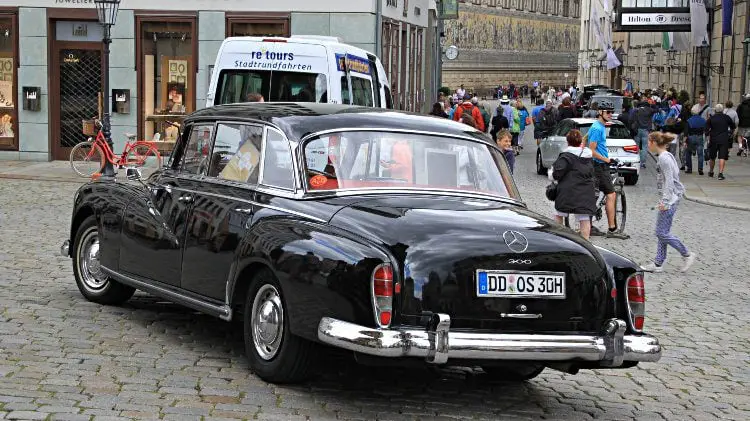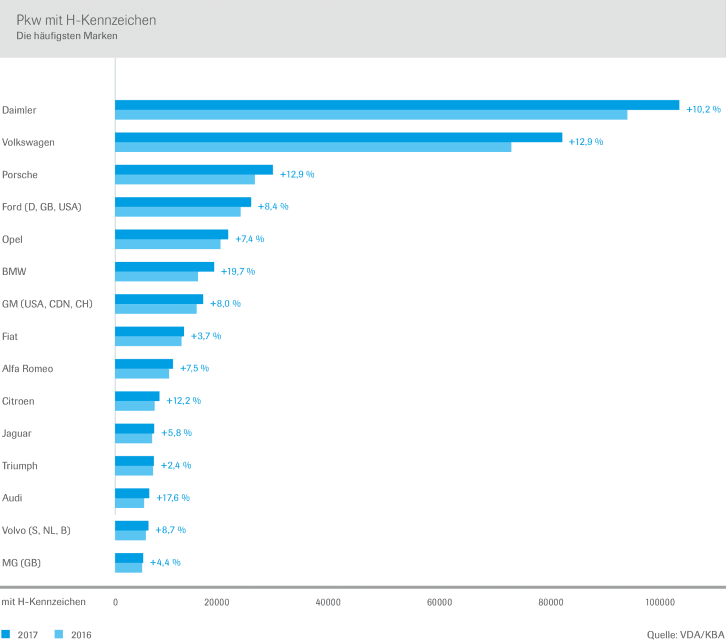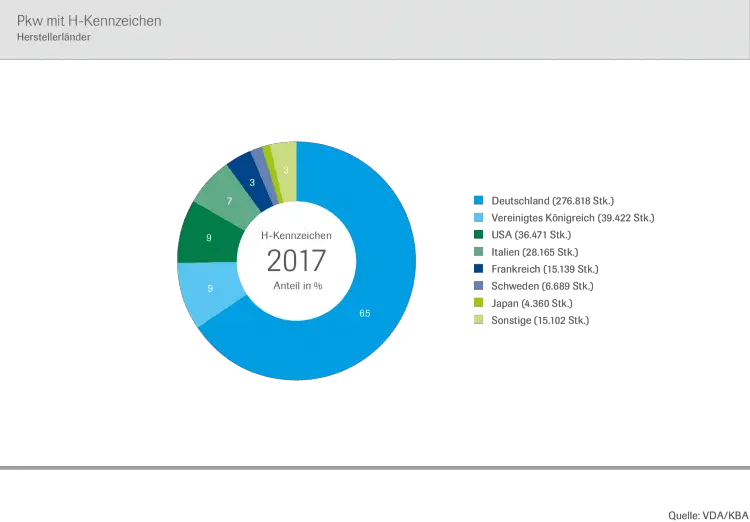Mercedes-Benz remains Germany’s favorite classic car brand while the Volkswagen Beetle is the most common car model on historic H plates in 2018.
The number of historic and classic cars in Germany in 2018 increased by 11% to 422,213 cars using H number plates for cars older than 30 years in good original condition. Mercedes-Benz, Volkswagen and Porsche are the favorite classic car brands in Germany but BMW and Audi are growing the fastest. The VW Beetle is by far the most common classic car on German roads followed by the Mercedes-Benz W123 and the Porsche 911.
Historic Number Plate Cars in Germany in 2018
The number of cars registered with historic number plates (H-Kennzeichen) in Germany on January 1, 2018, increased by 11% to 422,213 passenger cars (PKW) according to the VDA/KBA. The total number of historic number plate vehicles in Germany, including cars, trucks, buses and motorcycles, increased to 477,386.
H-number plates were introduced in Germany in 1997 and the popularity has increased in recent years. In the past decade, the number of car on historic number plates in Germany increased by 157%. In recent years, the increases have been around 11% per year:
| Year | Numbers |
% Change
|
| 2018 | 422,213 | 11 |
| 2017 | 381,027 | 10.8 |
| 2016 | 343,958 | 10.7 |
| 2015 | 310,694 | 11.3 |
| 2014 | 279,250 | |
| 2013 | 254,053 | |
| 2012 | 231,064 | |
| 2011 | 208,319 | |
| 2010 | 188,360 | |
| 2009 | 164,225 | |
| 2008 | 144,810 | |
| 2007 | 154,479 | |
| 2006 | 140,169 |
The Use of Historic H-Number Plates in Germany
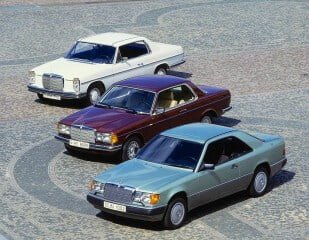
In Germany, cars older than 30 years are termed Oldtimer and may be registered as historic cars with an H in the number plate (H-Kennzeichen) if the car is well maintained and in a largely original condition. Such cars are considered to be of cultural and historic value. H-plates may have some tax benefits but increasingly the main benefit is that historic cars may be driven in Umweltzonen (environmental zone) without the need for a green sticker. (For diesel cars, these may be increasingly valuable but could potentially lead to calls for reducing the H-plate exceptions.)
Not all cars older than 30 years in Germany are on H-plates. Some don’t qualify due to modifications to the car and for others the financial benefits may not be sufficient to have the car evaluated and re-registered.
Furthermore, many classic cars are registered on seasonal numbers, i.e. the car is only registered for a specific number of months of the year, which brings tax and especially insurance savings for cars used only during summer months.
Also, according to Autobild, around 60,000 special red 07 number plates are issued in Germany. These are for cars not registered for normal road use but may be used for example for participating in classic car rallies and shows. Autobild estimates that three cars share each 07 number plate and thus another 180,000 or so classic cars may be on the road in Germany.
The average age of historic cars in Germany is 42 years. These cars are generally seen to be in very well maintained condition, which is one of the reasons the VDA and the motor trade lobby very hard for the special permissions to be maintained.
Most-Popular Classic Car Brands in Germany in 2018
According to the VDA, the following were the most-popular historic car makes in Germany at the start of 2018:
Mercedes-Benz has been the most popular marque for historic cars in Germany since the inception of the H-plate system. It shows both the longevity of classic Mercedes-Benz cars but also the interest and willingness of owners of Mercedes-Benz cars to maintain and preserve the vehicles.
Volkswagen is steadily catching up with Mercedes but still a distant second. The VW Beetle remains the most common historic car in Germany while the Golf has serious growth potential.
The number of historic BMWs has increased by a fifth in the past year while Audi was only slightly behind in percentage terms but with much lower numbers.
Probably the most-surprising marques on the list of popular historic car brands in Germany are those not selling particularly well in recent years such as GM (excluding Opel), Alfa Romeo, and Jaguar, as well as historic brands such as Triumph and MG. The survivors of these brands are clearly loved by their owners but the potential for increasing registrations are limited.
As with the German new car market, two-thirds of historic classic cars are from German brands, followed by British and American brands at around 9% each:
Most-Popular Historic Car Models in Germany in 2018
The fifteen most-popular classic car models in Germany using H-plate registrations numbers at the start of 2018, 2017 and 2017, as well as the total number of registered cars at the start of 2018 (H and normal plates) according to the KBA/VDA were:
| Brand | Model | H2018 | H2017 | H2016 | Total 30 Years Plus | |
| 1 | Volkswagen | Käfer (Beetle) | 36,258 | 34,648 | 32,750 | 51,009 |
| 2 | Mercedes-Benz | W 123 | 19,718 | 18,578 | 17,534 | 27,146 |
| 3 | Porsche | 911 / 912 | 15,840 | 14,052 | 10,498 | 19,762 |
| 4 | Mercedes-Benz | SL R 107 | 15,798 | 13,719 | 11,325 | 19,964 |
| 5 | Volkswagen | Bus | 11,975 | 10,183 | 7,736 | 22,019 |
| 6 | Volkswagen | Golf | 7,938 | 5,984 | 4,519 | 26,074 |
| 7 | Mercedes-Benz | /8 | 7,503 | 7,352 | 7,045 | 9,506 |
| 8 | Mercedes-Benz | W111 / Heckflosse | 5,799 | 6,097 | 5,242 | 6,447 |
| 9 | Mercedes-Benz | W113 / Pagode | 5,029 | 4,949 | 4,847 | 5,144 |
| 10 | Opel | Kadett | 4,930 | 4,685 | 4,280 | 13,482 |
| 11 | Mercedes-Benz | W 126 (S Class) | 4,829 | 3,746 | – | 7,703 |
| 12 | BMW | 3 Series | 4,679 | 2,944 | – | 12,877 |
| 13 | Porsche | 924/944 | 3,969 | 3,317 | 3,162 | 6,160 |
| 14 | Mercedes-Benz | W 108/109 | 3,811 | 3,693 | 3,310 | 4,086 |
| 15 | Mercedes-Benz | W 201 (190) | 3,765 | 2,383 | – | 9,351 |
The rank order of the ten most-popular historic car models in Germany remained largely unchanged from a year ago. Mercedes-Benz models are not helped by being split into the different production cycles while others such as the Golf, Kadett, and 911 are not differentiated by model versions.
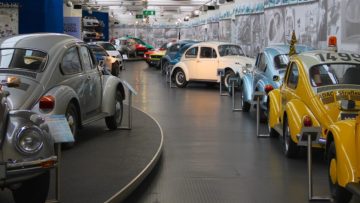 The VW Beetle (Käfer) easily maintained its position as the most common classic car on the road in Germany with more than 36,000 of the over 51,000 Beetles older than 30 years in Germany registered on H plates. Even the Golf will probably need a decade or more to ever dethrone the Beetle.
The VW Beetle (Käfer) easily maintained its position as the most common classic car on the road in Germany with more than 36,000 of the over 51,000 Beetles older than 30 years in Germany registered on H plates. Even the Golf will probably need a decade or more to ever dethrone the Beetle.
The Mercedes-Benz W123 (E-Class from the mid-1970s to mid-1980s) moved into second place in 2013 and is likely to remain there for a while. In 1980, this Mercedes was the best-selling car in Germany – the last time any car outsold the Golf in Germany over a calendar year period. Production stopped in 1986 so future H-plate growth is only possible from the around 7,000 cars not yet on H-plates.
The Porsche 911 moved ahead of the Mercedes SL R107 in 2017 and maintained the slight lead. The growth potential for the Porsche in coming years is better as the 911 name remains in use to the present, while production of the R107 stopped in 1989.
The VW Golf entered the top-ten list in 2015 and moved up another two positions in 2018 to better the Mercedes-Benz /8 and Heckflosse models. The Golf has the best growth potential among historic plate cars in Germany – although only 2,000 H-plates were added, the increase in the number of Golfs older than 30 years were three times higher and should overtake the W123 by 2019.
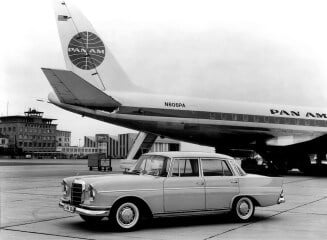
The Mercedes-Benz Heckflosse was the only top-15 model with lower cars registered on H-plates in Germany in 2018. The number of Heckflosse in total were also down – these cars could either have been written off, simple de-registered, changed to other number plates such as seasonal or 07, or sold abroad. The actual monetary value of the Heckflosse and /8 models are surprisingly low.
The Mercedes-Benz W113 Pagode maintained its ninth place and more noteworthy its position as the top model with the highest percentage of 30-year old cars on H-plates. Only 115 Pagodes in Germany are not on H-plates.
In contrast, the growth potential for the Opel Kadett, which is only 100 cars behind the Pagode, is enormous. However, many of the 30-year-old Kadetts were modified and thus fall short of the original condition requirement – a fate many older Golfs and 3 Series BMWs share.
The Mercedes-Benz W126 (S-Class of the 80s) is also only 200 cars behind the Pagode and likely to enter the top-ten list soon, if not beaten by the BMW 3 Series. The BMW 3 Series entered the top-15 list last year and moved up at least two positions and has huge growth potential.
While large Mercedes-Benz models from the 1960s and 1970s are slipping down the list – largely due to other models being more plentiful than in a decline in popularity – the Baby Benz from the 1980s have entered the list at 15. The Mercedes-Benz W201 (190) was produced until 1993 so the number qualifying for H-plates should continue to increase for another five years.
